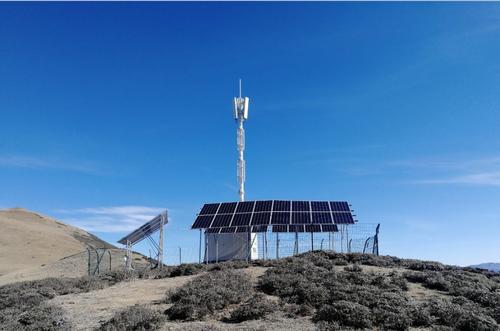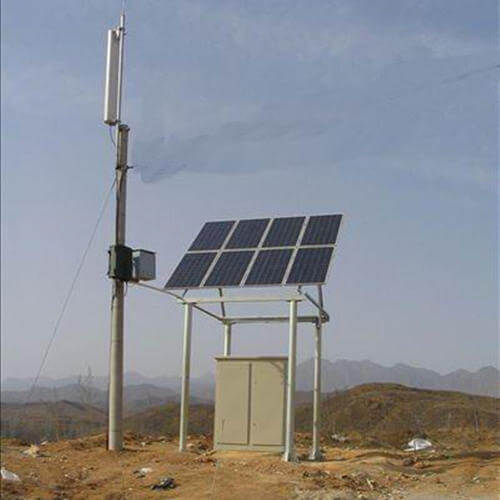Solar Telecommunications Base Station
More than 2 billion of the world’s 6.6 billion people are currently without adequate electricity, or about one third of the total population.
Areas without adequate electricity are mainly located in Africa, South America, Asia and South-East Asia. The Philippines and Indonesia, for example, have numerous islands and cannot build large-scale power grids in these small island areas. In some areas, the cost of building and maintaining large-area power grids is too high, such as china’s remote northwest, the land is sparsely populated, the introduction of the power grid to every pastoral family from an economic point of view is unreasonable.
1. The remote area communication base station power supply system selection.
Power supply systems in remote areas generally include power generation equipment, energy storage equipment, energy conversion and management equipment. Power generation equipment includes diesel generators, photovoltaic arrays, wind turbines or hydroelectric generators. Energy storage equipment usually has a battery pack or energy storage pool. Energy transformation and management equipment has DC converter, inverter and other equipment.
Diesel generators are the energy source of power supply systems in many remote areas, in order to maximize fuel efficiency and reduce maintenance, the load rate needs to be maintained at 60% to 70% of the rated load capacity of the generator. The output power of the wind turbine can reach 250W to 500kW, but the appropriate wind field needs to be selected with stable wind speed. Although the cost of power generation is relatively low, it needs to be selected to build on the moderate and stable river, the cost of power generation of the turbine generator is relatively low, but the cost of the generator is higher.
Communication network requires base stations and other equipment to provide 7 x 24 hours stable operation, base station equipment in addition to distribution in urban areas, but also a large number of distribution in desert, islands, mountaintops and other environments, covering a wide area, generally unattended, power reliability and life has high requirements. Photovoltaic cells of solar power supply system directly convert solar energy into electrical energy, provide the -48V voltage required by the base station by the string of photovoltaic modules, and realize the static transformation of energy, which is less maintenance work compared with generators with mechanical rotating components. For base station load smaller than 2kW, it is a suitable power supply system scheme in remote areas, especially under the trend of high global crude oil prices, the cost advantage of photovoltaic power generation system is becoming more and more obvious.
2.The communication base station photovoltaic power supply system.
The solar power supply system of the communication base station consists of photovoltaic modules, array brackets, sink boxes, charge and discharge controllers, battery packs, inverters, etc., as shown in Figure 2
Components generally use single-crystalsilicon or polysilicon batteries, each battery output voltage is about 0.5V, the general components use 72 solar cells in series, so in order to get 43.2 to 56.4V voltage range, two components need to be used in series. Power levels try to select larger production specifications, such as 165W, 170W and 175W and other specifications. Very small component specifications lead to increased bracket design costs and floor space, while oversized component specifications use a lower yield of solar cells and relatively high battery costs. Select the parallel number sit-in situ based on the load capacity and local solar energy resources.
Multiple pv modules are paralleled to form an array, supporting the components with galvanized steel brackets, giving the components a certain tilt angle while fixing the components against the wind. For independent photovoltaic systems, in order to reduce battery usage and system costs, the maximum solar irradiation is required in winter, so the inclination of the components needs to be set to be 10 to 20 degrees larger than the local latitude.
The battery pack continues to provide the required energy for the load when rainy weather or nighttime, no sunlight or irradiation weakens and does not provide the energy needed for the load. The capacity of the battery pack is determined according to the load capacity, the number of days of self-sufficiency in consecutive rainy days, and the depth of discharge.
In the past, liquid-rich lead-acid batteries (OPzS) were a common choice for photovoltaic power supply systems, as OPzS batteries use tubular positives to prevent active substances from falling off and thick negative plates to extend their service life. However, in recent years, more and more photovoltaic systems have turned to colloidal valve-controlled sealed lead-acid batteries (OPzV) of tube-shaped positive plates, mainly because valve-controlled sealed lead-acid batteries (VRLa) technologies require less maintenance.
Liquid-rich batteries require regular water maintenance, if not maintained in a timely manner, the battery life will be shortened, and the transport of deionized distilled water to remote areas of the base station requires higher costs. VRLA batteries, under normal operating conditions, only a few amounts of sulphuric acid and hydrogen are analyzed, greatly reducing the maintenance workload, and do not require the construction of a special room and the installation of special ventilation. Electrolyte stratification is the cause of the failure of many liquid-rich batteries, which are generally used to eliminate overcharge and usually require additional overcharge of up to 15%. Colloid batteries experience a negligible electrolyte stratification during operation and therefore do not suffer from stratification-related failures. Undercharging is a common cause of VRLA failure in power supply systems in remote areas, which is due to the accumulation and growth of lead sulfate crystals in battery active substances during the unstable rainy season, and studies show that the microporous partitions used in colloidal batteries are less likely to penetrate branches and crystals, and have better properties in this regard. Compared with the liquid-rich battery charging recovery capacity of 110% to 115%, the recharging recovery of colloidal cells is only 103% to 105%, and the improvement of charging efficiency is beneficial to saving photovoltaic energy.
3.Application Pictures





